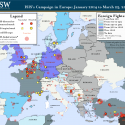Afghanistan ORBATs
The Afghanistan ORBAT (PDF) describes the location and area of responsibility of all American units in Afghanistan, down to the battalion level, updated as of March 2016.
The Afghanistan ORBAT (PDF) describes the location and area of responsibility of all American units in Afghanistan, down to the battalion level, updated as of March 2016.
The success or failure of the U.S. mission in Afghanistan has reached a critical juncture. Newly appointed Defense Secretary Ashton Carter announced on February 21, 2015 that the U.S. is considering a number of changes to the U.S. mission in Afghanistan.
"The Russians have developed a way of getting the U.S. formally to permit offensive Russian military operations against American partners on the ground, all the while calling it a ceasefire." Kimberly Kagan, Fox News Opinion, "How Russia Controls U.S. Policy"
The lead U.S. envoy for the anti-ISIS coalition told Defense One he shared ISW Research Director Jennifer Cafarella's concerns outlined in a report regarding ISIS's resurgence.
ISW's signature Syria maps and research were cited in a visual accompanying the quarterly Department of Defense Lead Inspector General Report to the U.S. Congress on the counter-ISIS mission.
“You can’t contain Iran in Syria without also dealing with the Russians,” Jennifer Cafarella told The Wall Street Journal in February 2019.
“It’s necessary to provide our own counterterrorism operation so that we can keep a lid on things and prevent these groups from being able to run around without fear of drone strikes,” Caitlin Forrest told The New York Times.

Pro-regime forces seized Palmyra as well as the adjacent Palmyra Airbase in Eastern Homs Province on March 27 after ISIS withdrew from the city, completing an operation that began on March 7 with the aim of recapturing the strategic crossroads.

ISIS is using its foreign fighters and safe haven in Iraq and Syria to execute a terror campaign within Europe. ISIS’s March 22 Brussels attacks support a larger strategy to punish, destabilize, and polarize the West. ISIS will likely continue to attempt attacks in France and Belgium in 2016, using its large Francophone foreign fighter population and local supporters.
ISIS is using its foreign fighters and safe haven in Iraq and Syria to execute a terror campaign within Europe. ISIS’s March 22 Brussels attacks support a larger strategy to punish, destabilize, and polarize the West. ISIS will likely continue to attempt attacks in France and Belgium in 2016, using its large Francophone foreign fighter population and local supporters. ISIS’s support networks in southern Europe may enable ISIS’s operatives to launch operations in other parts of the continent, including Austria, Germany, Spain, and Italy.